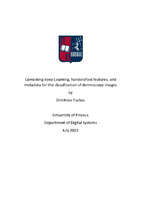| dc.description.abstractEN | Malignant melanoma is the worst type of skin cancer and one of the world's fastest-growing
malignancies. Early detection and identification of melanoma are critical for a high rate of full
cure. Moreover, the importance of patient and dermatologist understanding of early
melanoma signs and symptoms constitute a key factor for gaining useful experience
concerning the disease. Towards these pillars, automated melanoma diagnosing systems that
detect malignant skin lesions at early stages can support dermatologists to obtain objective
quantitative markers, to relieve the excessive load of work and facilitate telemedicine
capabilities. Deep learning-based approaches’ efficiency has soared in recent years, and they
now appear to outperform traditional machine learning methods in classification tasks.
In this master's thesis, Convolutional Neural Networks, handcrafted techniques, and metadata
are used to extract features from a set of 58,457 dermoscopy skin lesion images. The extracted
features from each technique, separately and in combination, are used to train machine
learning classifiers towards the creation of a classifier that returns efficient results in terms of
accuracy while, simultaneously, exploiting much simpler architectures than the state of the
art. A curated ablation study assists in the determination of the base model components for
the creation of the final architecture.
The proposed method was tested in the SIIM-ISIC 2020 melanoma classification, and it
involves the use of a combination of EfficientNet-B0 features, GLCM, LBP, color moments
features, and metadata features to improve model performance by 93,97% AUC score. | el |



